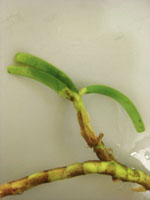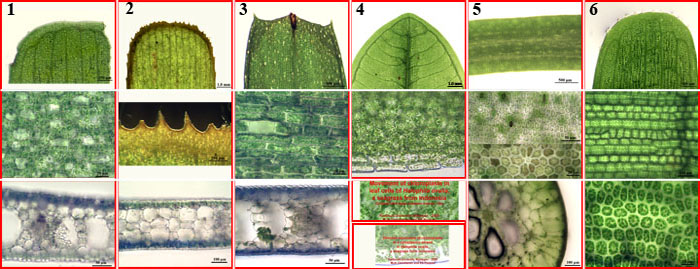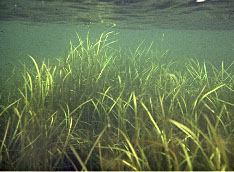 |
Common Eelgrass, Zostera marina
Photograph: Marieke van Katwijk |
Completely submerged water plants like seagrasses and pondweed (
Elodea canadensis) lack stomata. The leaves are mostly thin (e.g.
Zostera marina, here left) or thread-like (round but with a small diameter; e.g.
Syringodium isoetifolium). In general, a favorable ratio of surface (high) with respect to volume (small) is encountered. Fresh water plants have no water balance problems. They exchange gas optimally without risk of dessication through the thin cuticle which is air-permeable; the epidermis is also thin or event absent. Seagrasses by contrast have to struggle against the high salinity in their environment. The external cell wall is not so thin as in fresh water plants. The vascular system in water plants is reduced in general. Their buoyancy derives from large intercellular cavities that protrude into stems and roots and thus facilitate oxygen transport (Microscopical fluorescence and bright field views of
aerenchym in a Zostera leaf). The intensity of light underwater is relatively low; a true palisade parenchyma layer is often lacking.
Seagrasses

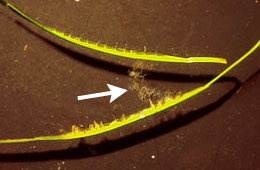
Seagrasses are often confused with algae, but they are fundamentally different. While algae are primitive plants, seagrasses have true leaves, stems, and often rhizomes and a root system with which they can have hold in the soil and they develop flowers that are involved in sexual reproduction. Thus, seagrasses as flowering plants, can produce pollen, fruits and seeds under water. (Pollen is indicated by an arrow on the photograph of flowering Common Eelgrass,
Zostera marina, here right; Photograph by Dr. J. D. Ackerman, used with permission).
The surface of leaves of seagrasses forms also a substrate on which all kinds of epiphytic algae can life
(fluorescence view of chloroplasts in a Zostera leaf and epiphytes;
stereo-anaglyph to be watched with a green filter for the left eye, and red one right, and a monochrome
gif animation).
A fresh water plant: Canadian waterweed (Elodea canadensis)

The leaves of Elodea are marked by the presence of only two cell layers with photosynthetic activity. The chloroplasts of these cells exhibit a circulating motion pattern (view a larger display of this film of the
cytoplasmic streaming; gif film; 731 KB)
| Completely submerged fresh water plant: the Canadian waterweed (pondweed) |
 |
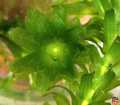 |
 |
| Tip of a branch |
Top view of the branch tip |
Leaf surface |
 |
 |
 |
| Sectioned tip |
Young initial leaf |
Older initial leaf |

 Seagrasses are often confused with algae, but they are fundamentally different. While algae are primitive plants, seagrasses have true leaves, stems, and often rhizomes and a root system with which they can have hold in the soil and they develop flowers that are involved in sexual reproduction. Thus, seagrasses as flowering plants, can produce pollen, fruits and seeds under water. (Pollen is indicated by an arrow on the photograph of flowering Common Eelgrass, Zostera marina, here right; Photograph by Dr. J. D. Ackerman, used with permission).
Seagrasses are often confused with algae, but they are fundamentally different. While algae are primitive plants, seagrasses have true leaves, stems, and often rhizomes and a root system with which they can have hold in the soil and they develop flowers that are involved in sexual reproduction. Thus, seagrasses as flowering plants, can produce pollen, fruits and seeds under water. (Pollen is indicated by an arrow on the photograph of flowering Common Eelgrass, Zostera marina, here right; Photograph by Dr. J. D. Ackerman, used with permission).


